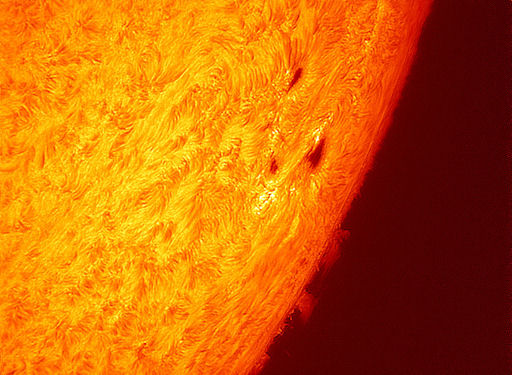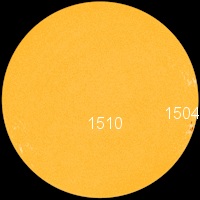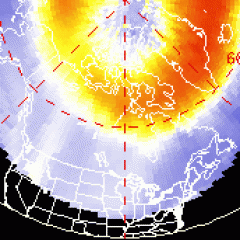~Space Weather Update~ Departing Sunspot~ [1]
WHY WON'T THE SUPERNOVA EXPLODE? A question has been troubling astronomers: Why won't the supernova explode? Although real stars blow up, the best computer models of dying stars do not result in much of a bang. NASA has launched a new observatory named "NuSTAR" to seek out the missing physics of stellar explosions. [video [2]] [full story [3]]
DEPARTING SUNSPOT: Big sunspot AR1504, the source of so many auroras [4] on June 16th and 17th, is leaving the solar disk. Dave Gradwell of Birr, Ireland, photographed the active region yesterday as it approached the sun's southwestern limb:
"AR1054 is waving goodbye after putting on a great show," says Gradwell.
Although the sunspot is not directly facing Earth, it could still affect our planet. Magnetically speaking, Earth is well-connected to AR1504's location on the southwestern limb. A solar flare now could accelerate charged particles, which would be guided in our direction by curved lines of magnetic force. NOAA forecasters estimate a 10% chance of M-class [6] solar flares from AR1504 during the next 24 hours. Solar flare alerts: text [7], voice [8].

![]()
Solar wind
speed: 420.3 km/sec
density: 0.6 protons/cm3
explanation [9] | more data [10]
Updated: Today at 1506 UT
![]()
X-ray Solar Flares
6-hr max: B4 1055 UT Jun21
24-hr: B4 1055 UT Jun21
explanation [6] | more data [11]
Updated: Today at: 1500 UT
![]()
![]()
![]()
Daily Sun: 21 Jun 12
![]()
![]()
Sunspot 1504 is about to disappear over the sun's SW limb, ending the threat of Earth-directed eruptions. Credit: SDO/HMI
![]()
![]()
![]()
Sunspot number: 46
What is the sunspot number? [13]
Updated 20 Jun 2012
Spotless Days
Current Stretch: 0 days
2012 total: 0 days (0%)
2011 total: 2 days (<1%)
2010 total: 51 days (14%)
2009 total: 260 days (71%)
Since 2004: 821 days
Typical Solar Min: 486 days
Updated 20 Jun 2012
The Radio Sun
10.7 cm flux: 104 sfu
explanation [14] | more data [15]
Updated 20 Jun 2012
![]()
![]()
![]()
Current Auroral Oval:
![]()
Switch to: Europe, USA, New Zealand, Antarctica
Credit: NOAA/POES
![]()
![]()
![]()
Planetary K-index
Now: Kp= 1 quiet
24-hr max: Kp= 1 quiet
explanation [17] | more data [18]
![]()
Interplanetary Mag. Field
Btotal: 6.1 nT
Bz: 1.9 nT north
explanation [19] | more data [20]
Updated: Today at 1506 UT
![]()
![]()
![]()
Coronal Holes: 21 Jun 12
![]()
![]()
A coronal hole is emerging over the sun's NE limb. Credit: SDO/AIA.
Category:
- Ground Crew Updates [22]



